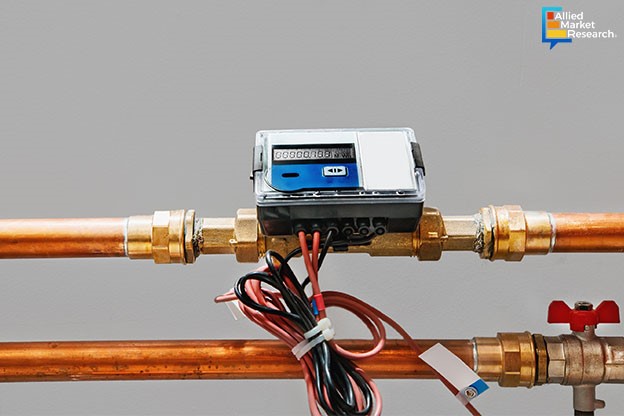Why Should Equipment Businesses Invest in IoT-enabled Heat Meters?

30 Apr
2024
Highlights
- Introduction
- The potential of IoT-enabled heat meters
- Recent advancements in the sector
Heat meters are vital in precisely measuring and controlling energy consumption within heating systems. These systems consolidate heat production and distribution, requiring accurate measurement for billing and optimization purposes. It is essential for measuring thermal energy consumption and ensuring fair billing in homes, buildings, and industries. It assesses heat transfer from sources such as boilers or district heating, providing precise measurements on the basis of fluid flow rates and temperatures. Utilized across residential, commercial, and industrial settings, it optimizes energy usage, facilitates equitable allocation of heating costs, and assists in process analysis & efficiency improvements.
Integration of IoT for improved efficiency of heat meters
IoT-enabled heat meters facilitate wireless communication of heat consumption data, eliminating the necessity of manual meter readings. This streamlined process enhances efficiency and reduces operational costs for utilities.
Smart heat meters with IoT connectivity enable Heat Cost Allocation (HCA) in multi-dwelling buildings. HCA ensures that each tenant is billed according to their actual heat consumption rather than a flat rate. This approach promotes energy conservation and fairness among consumers.
Smart heat meters with IoT capabilities offer additional features such as remote monitoring, predictive maintenance, and integration with smart home or building automation systems. These functionalities enable optimized energy usage and enhance overall efficiency.
Other prominent trends in the heat meter industry
One of the primary trends that fuels the expansion of the smart heat meter sector is the growing emphasis on reducing carbon emissions and advocating for sustainable energy consumption practices. Governments and regulatory bodies have incorporated strict regulations and policies to optimize the adoption of smart heat meters across residential, commercial, and industrial sectors.
Heat meters generate significant volumes of data, and the trend has shifted toward utilizing this data for predictive maintenance and boosting energy usage patterns. The shift toward decentralized energy generation, which includes sources such as geothermal and solar thermal, has influenced the heat meter sector. Heat meters play a vital role in accurately measuring both energy consumption and production in these decentralized systems.
Moreover, the increase in adoption of energy performance contracts drives the demand for precise verification and measurement of energy savings. Heat meters validate the efficiency of energy-efficient solutions, ensuring reliable measurement and verification processes.
Strategic alliances transform the outlook of the heat meter sector
The global heat meters industry is anticipated to manifest the fastest CAGR of 5.4% by 2032. The growth is attributed to a surge in demand for energy efficiency and the rise in adoption of district heating systems. Moreover, top players have integrated novel strategies to dominate the competitive industry. For instance, in February 2021, Karlshamn Energi, a utility based in Sweden, chose Kamstrup for its smart meter programs for both heat and water customers. Kamstrup supplies smart meters, along with the related infrastructure, the READy remote reading system, and the analytics tool Leak Detector. The smart meters installed in Karlshamn enable the utility to efficiently automate readings and detect suspicious leaks in the distribution network.
On the other hand, Micronics introduced the new U1000-WM to its ULTRAFLO range of Clamp-on, Heat/Energy, and Flow meters in May 2021. The U1000 Heat/Energy and Flow meters are now offered in both the original pipe-mounted configuration and the newly added wall-mounted option, complete with a display and keyboard. In addition, the U1000-WM features an extended pipe range to accommodate various applications.
To conclude, a heat meter assesses the heat transfer from sources such as boilers or district heating, providing precise measurements based on fluid flow rates and temperatures. IoT-enabled heat meters facilitate wireless communication of heat consumption data, eliminating the necessity for manual meter readings. Top entities have adopted novel strategies to strengthen their position in the dynamic industry.
Contact our experts for detailed estimations and investment opportunities in the global heat meters industry.

Koyel Ghosh
Author’s Bio- Koyel Ghosh is a blogger with a strong passion and enjoys writing in miscellaneous domains, as she believes it lets her explore a wide variety of niches. She has an innate interest in creativity and enjoys experimenting with different writing styles. A writer who never stops imagining, she has been serving the corporate industry for the last five years.
Unconventional Oil Extraction: How Are Technological Advancements Paving the Way for the Industry�s Expansion?
Avenue: Entire Library membership of Allied Market Research Reports at your disposal
- Avenue is an innovative subscription-based online report database.
- Avail an online access to the entire library of syndicated reports on more than 2,000 niche industries and company profiles on more than 12,000 firms across 11 domains.
- A cost-effective model tailored for entrepreneurs, investors, and students & researchers at universities.
- Request customizations, suggest new reports, and avail analyst support as per your requirements.
- Get an access to the library of reports at any time from any device and anywhere.
Related Post
-
How are Submarine Cables Transforming Global Connectivity with Enhanced User Experience?
-
Endoscopy Procedures: Transformations in Techniques and Applications
-
AI-Powered Video Analytics: How the Product Actually Works for enterprises
-
Painting Robots: Transforming Precision Coating and Creative Applications
-
Innovations in Pharmacovigilance Systems Advancing Patient Safety
-
Understanding Edge Security: Keeping Data Safe Near the Source
-
Exploring the Use and Advancements of 3D Laser Scanners in Professional Applications
-
Reinforcing Industrial Controls with Smarter Tools and Training








